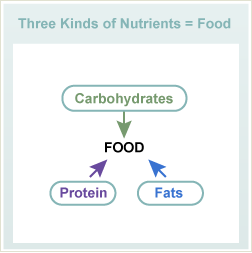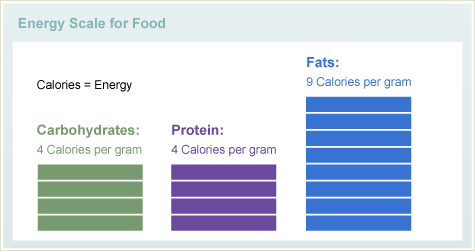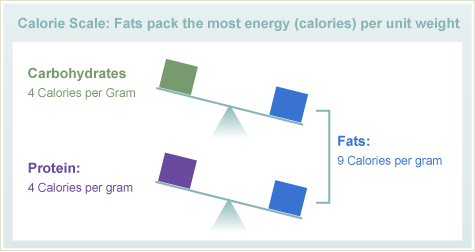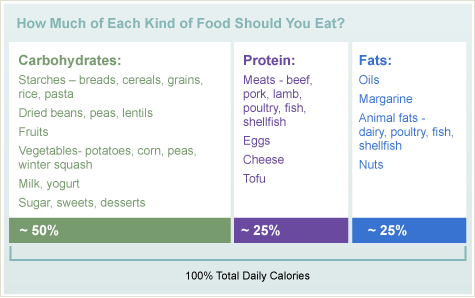Ada 1200 Calorie Diet Counting Fats Carbs Proteins
This page is an overview, and you will learn general information about:
- The three main sources of calories in food:
Carbohydrate, Protein, Fat - How to eat a balanced diet
- Helpful meal planning tools
The subsequent sections provide more detailed information:
- Understanding Carbohydrates
- Understanding Fats and Oils
- Understanding Protein
- Diabetes and Alcohol
- Heart Health
Main sources of calories in food
To begin with, let's talk about food in general. We obtain nutrition through the various foods we eat. Foods supply critical vitamins and minerals essential for health. Foods also supply us with energy, or calories. To keep your body running, you need three types of food:
- Carbohydrate
- Protein
- Fat

Calories in food
However, all food is not equal in calories. Fat, for example, has more than twice the calories, gram for gram, as equal amounts of carbohydrates or protein.
- Fat = 9 calories per gram
- Carbohydrate = 4 calories per gram
- Protein = 4 calories per gram


How much carbohydrate, protein and fat do I need each day?
There is not and ideal mix of carbohydrate, protein and fat that is right for everyone.
Targets depend on your calorie goals, body weight, lipid profile, blood glucose control, activity levels, and personal preferences. A registered dietitian can help design a meal plan that is right for you.
The 2015-2020 Dietary Guidelines for Americans suggest:
- Carbohydrates – 45 to 65% of your daily calories *
- Protein – 10 to 35% of your daily calories
- Fat- 20 to 35% of your daily calories
* The Dietary Reference Intake (DRI) for carbohydrates is 130 grams per day. This is the "minimum" suggested intake for most people.
The following is an example fuel mix. Your targets may vary.

Carbohydrates
If you have diabetes, it is essential to learn about carbohydrates.
Why? Because among all the foods, carbohydrates have the largest effect on your blood sugar. Carbohydrates include starches and sugars.
During digestion, both forms of carbohydrate break down in your body to single units of sugar, called glucose. Carbohydrate is an important part of your diet because the most common sugar unit, glucose, is your body's preferred source of energy or fuel. Your brain, blood cells, muscles, and other tissues all require an adequate supply of glucose.
You don't need to avoid carbohydrates because of diabetes. Just be able to identify which foods have carbohydrates, and then control the amount you eat.
Carbohydrates are found in:
- Rice, grains, cereals, and pasta
- Breads, tortillas, crackers, bagels and rolls
- Dried beans, split peas and lentils
- Starchy vegetables like potatoes, yams, corn, peas and winter squash
- Non-starchy vegetables such as broccoli, green beans, carrots, and zucchini contain smaller amounts of carb
- Fruit
- Milk
- Yogurt
- Sugars, like table sugar and honey
- Foods and drinks made with sugar, like regular soft drinks and desserts
If you have type 1 diabetes, you must balance your carbohydrate intake and your insulin dose. To get the best blood sugar result, your carbohydrate count must be accurate. Carbohydrates are counted in grams, which is a measure of weight – and even a few grams more or less can make a difference in your blood sugar reading.
Similarly, if you have type 2 diabetes, and are treated with medications that cause insulin to be released from the pancreas (Insulin Secretagogues), or insulin, you also must balance your carbohydrate intake and your medication dose. To get the best blood sugar result, your carbohydrate count must be accurate.
Carbohydrates are counted in grams, which is a measure of weight – and even a few grams more or less can make a difference in your blood sugar reading.
Proteins
Protein is an essential part of your diet — and your body. But too much of a good thing can be bad for you. Most meats have fat as well as protein. So excess protein from animal sources can mean excess calories and fat – which means a greater chance at gaining weight.
Proteins are found in:
- Beef, pork, lamb
- Poultry
- Fish and shellfish
- Eggs
- Dairy products, like cottage cheese and regular cheese
- Plant-based proteins, like beans, nuts, and tofu
The best advice about protein? Get what you need from leaner protein sources like lean meats, poultry and fish, low fat or nonfat dairy products, and vegetarian protein sources like tofu.
If you have kidney problems, you should discuss protein targets with your doctor and dietitian.
Fats
Fat is another important part of your diet. Remember that fat has more than twice the calories as equal amounts of carbohydrate or protein. Controlling fat intake may help with weight control. Choosing heart-healthy fats can help prevent heart and blood vessel disease.
Fats are found in:
- Butter and margarine
- Oils, like vegetable oil, olive oil and canola oil
- Coconut oil
- Salad dressing and mayonnaise
- Nuts and seeds
- Avocado
- Meat and protein foods, like beef, cheese, bacon and hot dogs
Some fats and oils are heart healthy; others are not. Animal fats (in meat and dairy products) tend to be saturated fats and excess consumption can increase blood cholesterol levels. Opt for liquid vegetable oil instead. The fat in fish is the heart-healthy omega 3 type.
How to Eat a Balanced Diet
It is important to eat a varied and well-balanced diet, especially if you are trying to lose weight to manage your diabetes. Cutting calories should not lead to cutting nutrition. There are a variety of meal planning tools that you can use to help plan healthy, balanced meals.
Choose MyPlate
The MyPlate tool can be used to guide food choices. An interactive website – www.choosemyplate.gov – helps you create a personalized meal plan based on your age, gender and physical activity. This system encourages eating whole grains, fresh fruits and vegetables, lower fat dairy products and leaner proteins. It also emphasizes the importance of portion control and daily exercise. There are printable handouts for tips on selecting nutrient-rich fruits and vegetables, whole grains, and healthier fats. MyPlate also includes sample menus. Visit www.choosemyplate.gov.
Exchange Lists for Diabetes: Choose Your Foods
In the exchange system, foods with a similar amount of carbohydrate, protein and fat per serving size are grouped together. The foods within each list can be "exchanged" for one another during meal planning and end up with about the same amount of calories and nutrients.
Of course, we don't think of food as purely protein, purely fat or purely carbohydrate. Different foods are usually a mix of all three. To deal with this, we put food into six major exchange food groups based on each food's main content:
- Starch List (includes breads, grains, cereals, pasta, legumes, and starchy vegetables)
- Fruit List
- Milk List (includes milk and yogurt)
- Vegetable List (includes the non-starchy vegetables)
- Meat and Meat Substitutes List (includes meat, poultry, fish, cheese, tofu, eggs)
- Fat List (includes oils, avocado, nuts, butter, mayonnaise, margarine, cream cheese)
The chart below shows you the amount of calories and nutrients in one serving from each exchange food group:
| Food List | Carbohydrate (grams) | Protein (grams) | Fat (grams) | Calories | |
|---|---|---|---|---|---|
Carbohydrates | |||||
| Starch | 15 | 0-3 | 0-1 | 80 | |
| Fruits | 15 | - | - | 60 | |
| Milk | |||||
| Fat-free, low-fat, 1% | 12 | 8 | 0-3 | 100 | |
| Reduced-fat, 2% | 12 | 8 | 5 | 120 | |
| Whole | 12 | 8 | 8 | 160 | |
| Non-starchy Vegetables | 5 | 2 | - | 25 | |
Meat and Meat Substitutes | |||||
| Lean | varies | 7 | 0-3 | 45 | |
| Medium-fat | - | 7 | 4-7 | 75 | |
| High-fat | - | 7 | 8+ | 100 | |
| Plant-based proteins | varies | 7 | varies | varies | |
Fats | |||||
| Fats | - | - | 5 | 45 | |
It is important to eat foods from all six lists. The exchange system is designed to help you eat a balanced diet with the right amounts of carbohydrate, protein and fat. The meat and meat substitute list is separated into lean, medium fat, and high fat. For weight control and heart health choose lean most often and limit the high fat selections. The fat list is separated into heart-healthy monounsaturated and polyunsaturated fats (choose most often) and the saturated fats (limit or avoid).
View a sample list of food exchanges
When learning to use the exchange system for the first time, follow these helpful steps:
- Think about your usual foods and food preferences, and locate where each food falls on the exchange list.
- Familiarize yourself with the specific serving sizes listed for each food item that equal one exchange.
- Learn the number of exchanges you need from each food list to plan your daily meals and snacks.
Meal Planning Tips
The menu-planning table below can be used to stay within a specific calorie goal.
How to use this table
Choose your daily calorie allowance from the first column on the left. Then look across the table to see how many starch, fruit, milk, vegetable, meat and protein, and fat exchanges you can have. These are the total portions or exchanges for the entire day – and should be divided up between the different meals and snacks. For examples of 1200 calorie and 1600 calorie meal plans using the exchange lists, see the links below the table.
| Sample Exchange Daily Meal Plans | ||||||
|---|---|---|---|---|---|---|
| Calories | Starch Portions | Fruit Portions | Milk Portions* | Vegetable Portions | Meat & Protein Portions | Fat Portions |
| 1200 | 5 | 3 | 2 | 2 | 4 | 3 |
| 1300 | 6 | 3 | 2 | 2 | 4 | 3 |
| 1400 | 6 | 3 | 2 | 2 | 5 | 4 |
| 1500 | 7 | 3 | 2 | 3 | 5 | 4 |
| 1600 | 7 | 3 | 3 | 3 | 5 | 4 |
| 1700 | 8 | 3 | 3 | 3 | 5 | 5 |
| 1800 | 8 | 3 | 3 | 4 | 6 | 5 |
| 1900 | 9 | 3 | 3 | 4 | 6 | 5 |
| 2000 | 9 | 4 | 3 | 5 | 6 | 6 |
| 2100 | 10 | 4 | 3 | 5 | 6 | 6 |
| 2200 | 11 | 4 | 3 | 5 | 6 | 7 |
| 2300 | 12 | 4 | 3 | 5 | 6 | 7 |
| 2400 | 12 | 4 | 3 | 5 | 8 | 8 |
| 2500 | 13 | 4 | 3 | 5 | 8 | 8 |
| * Based on non-fat milk, 50% selections from lean meat list, and 50% selections from medium fat meat list. | ||||||
- View a sample list of food exchanges
- View a sample 1200 calorie meal plan using the Exchange Lists for Diabetes
- View a sample 1600 calorie meal plan using the Exchange Lists for Diabetes
It may seem overwhelming at first – but like any new skill, with practice it becomes second nature. Your registered dietitian can help you choose a calorie goal and meal plan that keeps your food, medication and physical activity in mind.
Self-assessment Quiz
Self assessment quizzes are available for topics covered in this website. To find out how much you have learned about Understanding Food, take our self assessment quiz when you have completed this section. The quiz is multiple choice. Please choose the single best answer to each question. At the end of the quiz, your score will display. If your score is over 70% correct, you are doing very well. If your score is less than 70%, you can return to this section and review the information.
Ada 1200 Calorie Diet Counting Fats Carbs Proteins
Source: https://dtc.ucsf.edu/living-with-diabetes/diet-and-nutrition/understanding-food/
0 Response to "Ada 1200 Calorie Diet Counting Fats Carbs Proteins"
Post a Comment